八年级英语上册unit8语法
- 格式:doc
- 大小:21.00 KB
- 文档页数:2
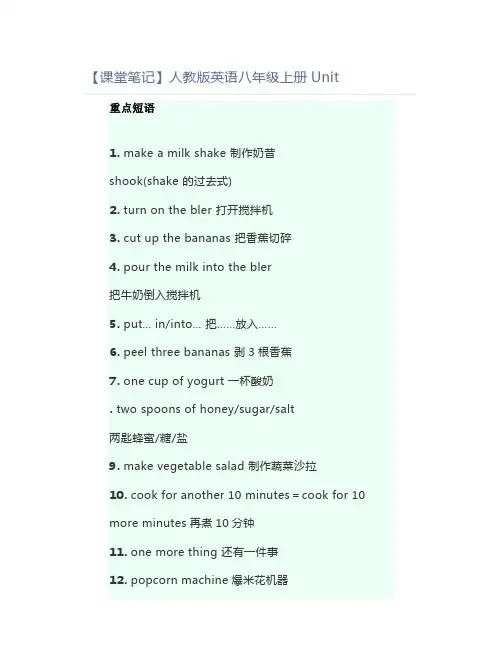
【课堂笔记】人教版英语八年级上册Unit 重点短语1. make a milk shake 制作奶昔shook(shake 的过去式)2. turn on the bler 打开搅拌机3. cut up the bananas 把香蕉切碎4. pour the milk into the bler把牛奶倒入搅拌机5. put... in/into... 把……放入……6. peel three bananas 剥3根香蕉7. one cup of yogurt 一杯酸奶. two spoons of honey/sugar/salt两匙蜂蜜/糖/盐9. make vegetable salad 制作蔬菜沙拉10. cook for another 10 minutes=cook for 10more minutes再煮10分钟11. one more thing 还有一件事12. popcorn machine爆米花机器13. dig a hole 挖洞dug; digging(dig的过去式以及现在分词) 14. take out a book from the library从图书馆借书15. put butter on a piece of bread把黄油涂在一片面包上16. the most traditional food 最传统的食物17. on the fourth Thursday in November 在十一月第四个星期四1. add... to... 把……加到……19. mashed potatoes 土豆泥20. pumpkin pie 南瓜饼21. the main dish of the meal 一餐的主菜22. fill... with... 用……把……装满23. place... on... 把……放在……上24. cover... with... 用……覆盖……25. cut... into thin pieces把……切成薄片26. serve it to your fris用它来款待你的朋友们27. cook it at a very high temperature以高温烹饪2. to make this special food为了制作这特别的食物29. a pot of hot soup 一锅热汤30. one by one 一个接一个重点句型1. How many bananas do we need?我们需要多少根香蕉?2. How much yogurt do we need?我们需要多少酸奶?3. I want to make Russian soup for a party on Saturday. 我想为周六的派对做罗宋汤。
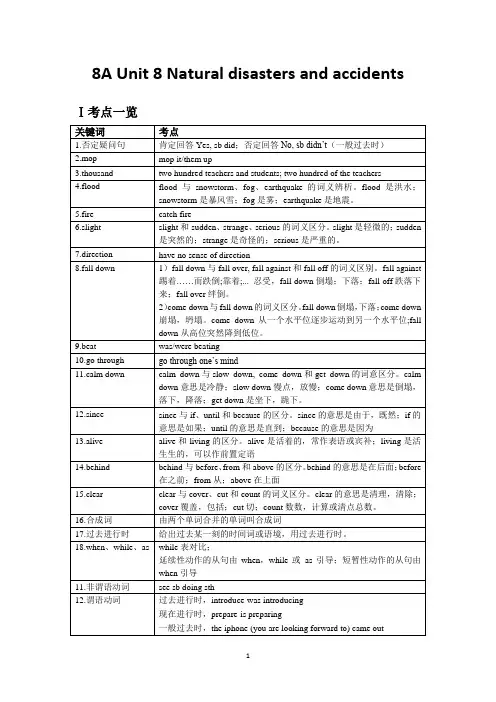
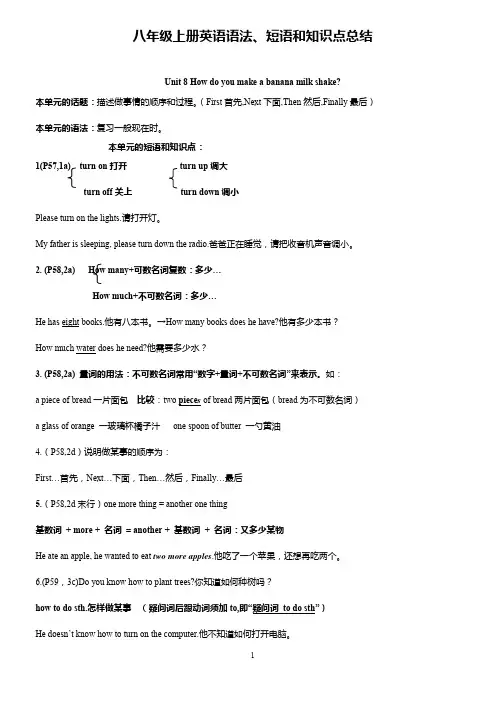
八年级上册英语语法、短语和知识点总结Unit 8 How do you make a banana milk shake?本单元的话题:描述做事情的顺序和过程。
(First首先,Next下面,Then然后,Finally最后)本单元的语法:复习一般现在时。
本单元的短语和知识点:1(P57,1a) turn on打开turn up调大turn off关上turn down调小Please turn on the lights.请打开灯。
My father is sleeping, please turn down the radio.爸爸正在睡觉,请把收音机声音调小。
2. (P58,2a) How many+可数名词复数:多少…How much+不可数名词:多少…He has eight books.他有八本书。
→How many books does he have?他有多少本书?How much water does he need?他需要多少水?3. (P58,2a) 量词的用法:不可数名词常用“数字+量词+不可数名词”来表示。
如:a piece of bread一片面包比较:two piece s of bread两片面包(bread为不可数名词)a glass of orange 一玻璃杯橘子汁one spoon of butter 一勺黄油4.(P58,2d)说明做某事的顺序为:First…首先,Next…下面,Then…然后,Finally…最后5.(P58,2d末行)one more thing = another one thing基数词+ more + 名词= another + 基数词+ 名词:又多少某物He ate an apple, he wanted to eat two more apples.他吃了一个苹果,还想再吃两个。
6.(P59,3c)Do you know how to plant trees?你知道如何种树吗?how to do sth.怎样做某事(疑问词后跟动词须加to,即“疑问词to do sth”)He doesn’t know how to turn on the computer.他不知道如何打开电脑。
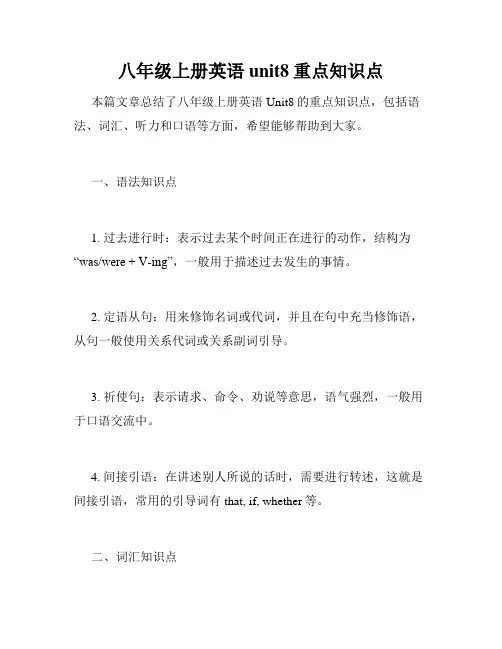
八年级上册英语unit8重点知识点本篇文章总结了八年级上册英语Unit8的重点知识点,包括语法、词汇、听力和口语等方面,希望能够帮助到大家。
一、语法知识点1. 过去进行时:表示过去某个时间正在进行的动作,结构为“was/were + V-ing”,一般用于描述过去发生的事情。
2. 定语从句:用来修饰名词或代词,并且在句中充当修饰语,从句一般使用关系代词或关系副词引导。
3. 祈使句:表示请求、命令、劝说等意思,语气强烈,一般用于口语交流中。
4. 间接引语:在讲述别人所说的话时,需要进行转述,这就是间接引语,常用的引导词有that, if, whether等。
二、词汇知识点1. science fiction:科幻小说,常用于描述未来世界、外星人等科幻元素的小说。
2. robot:机器人,常见于科幻小说、电影等作品中。
3. virtual reality:虚拟现实,描述了一种虚拟的、仿真的现实感觉。
4. scientist:科学家,研究和发展新科技的专业人士。
5. astronaut:宇航员,进行太空航行和空间探索的专业人士。
三、听力知识点听力在英语学习中占有非常重要的地位,通过大量的听力训练,可以提高对于英语语境的理解和听力技能。
在Unit8中,学生需要注意不同发音和语速的英语口音,并且注意语音的语调和节奏。
四、口语知识点除了听力,英语口语也是英语学习中需要重点关注的方面。
在Unit8中,学生需要注意语音语调和单词发音,尤其是英文中常使用的缩写和简化表达方式,例如gonna, wanna等。
同时,在口语交流中,还需要注意描写场景、情境,使用适当的形容词和副词,以及使用正确的语法结构和时间形式。
五、结语八年级上册英语Unit8是英语学习中的重要部分,其中涉及到的语法、词汇、听力和口语等方面都需要学生重视,并以实际练习为主。
希望本文所述的重点知识点能够帮助到大家,提升英语水平,更好地掌握英语学习。
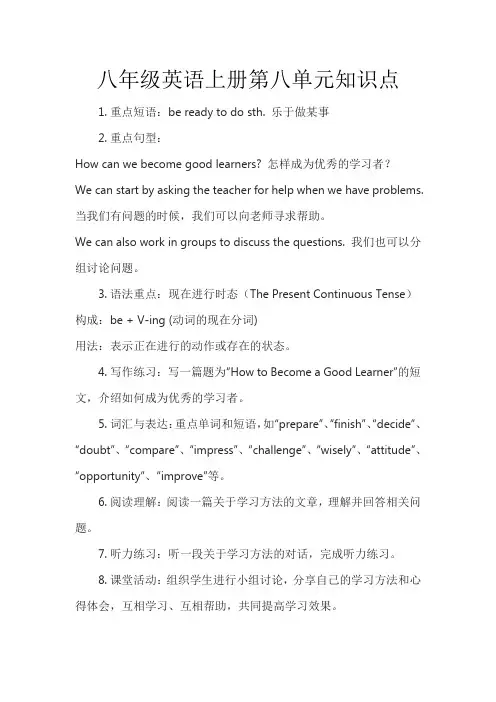
八年级英语上册第八单元知识点
1.重点短语:be ready to do sth. 乐于做某事
2.重点句型:
How can we become good learners? 怎样成为优秀的学习者?
We can start by asking the teacher for help when we have problems. 当我们有问题的时候,我们可以向老师寻求帮助。
We can also work in groups to discuss the questions. 我们也可以分组讨论问题。
3.语法重点:现在进行时态(The Present Continuous Tense)构成:be + V-ing (动词的现在分词)
用法:表示正在进行的动作或存在的状态。
4.写作练习:写一篇题为“How to Become a Good Learner”的短文,介绍如何成为优秀的学习者。
5.词汇与表达:重点单词和短语,如“prepare”、“finish”、“decide”、“doubt”、“compare”、“impress”、“challenge”、“wisely”、“attitude”、“opportunity”、“improve”等。
6.阅读理解:阅读一篇关于学习方法的文章,理解并回答相关问题。
7.听力练习:听一段关于学习方法的对话,完成听力练习。
8.课堂活动:组织学生进行小组讨论,分享自己的学习方法和心得体会,互相学习、互相帮助,共同提高学习效果。
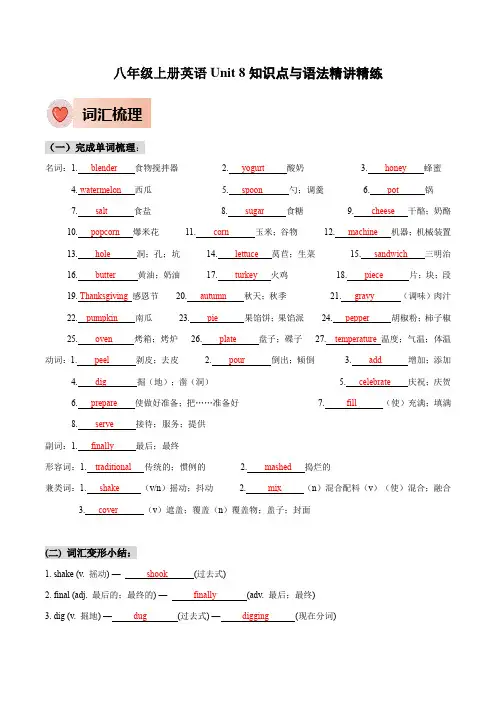
八年级上册英语Unit 8知识点与语法精讲精练词汇梳理(一)完成单词梳理:名词:1. blender食物搅拌器 2. yogurt 酸奶 3. honey 蜂蜜4. watermelon 西瓜5. spoon 勺;调羹6. pot 锅7. salt 食盐8. sugar 食糖9. cheese 干酪;奶酪10. popcorn 爆米花11. corn 玉米;谷物12. machine 机器;机械装置13. hole 洞;孔;坑14. lettuce 莴苣;生菜15. sandwich 三明治16. butter 黄油;奶油17. turkey 火鸡18. piece 片;块;段19. Thanksgiving 感恩节20. autumn 秋天;秋季21. gravy (调味)肉汁22. pumpkin 南瓜23. pie 果馅饼;果馅派24. pepper 胡椒粉;柿子椒25. oven 烤箱;烤炉26. plate 盘子;碟子27. temperature 温度;气温;体温动词:1. peel 剥皮;去皮 2. pour 倒出;倾倒 3. add 增加;添加4. dig 掘(地);凿(洞)5. celebrate 庆祝;庆贺6. prepare 使做好准备;把……准备好7. fill (使)充满;填满8. serve 接待;服务;提供副词:1. finally 最后;最终形容词:1. traditional 传统的;惯例的 2. mashed 捣烂的兼类词:1. shake (v/n)摇动;抖动 2. mix (n)混合配料(v)(使)混合;融合3. cover (v)遮盖;覆盖(n)覆盖物;盖子;封面(二) 词汇变形小结:1. shake (v. 摇动) — shook (过去式)2. final (adj. 最后的;最终的) — finally (adv. 最后;最终)3. dig (v. 掘地) — dug (过去式) — digging (现在分词)4. tradition (n. 传统) — traditional (adj. 传统的;惯例的) — traditionally (adv.传统地;惯例地)5. celebrate (v. 庆祝;庆贺) — celebration (n. 庆典;庆祝活动)6. prepare (v. 使做好准备) — preparation (n. 准备;准备工作)【练一练】用所给词的适当形式填空1.My father __finally___(final) agreed to let me go on the trip.2.I __shook____(shake) the medicine bottle before I took the medicine.3.Jack ate three __tomatoes___ (tomato) for breakfast this morning.4.The boys ___dug_____ (dig) twenty holes for the trees last Sunday.5.The Spring Festival is a __traditional___ (tradition) festival in China..6.Some friends of mine like to eat __sandwiches___ (sandwich) with onions.7.My brother often ___mixes____(mix) his Chinese books and English books.8.Why not ___serve____ (serve) the soup to your friend, Kate?9.My sister helped me ___to pour___ (pour) the water into the cup.10.Could you please tell me how ___to make___ an apple shake? (make)(三) 短语攻关:milk shake 奶昔turn on 接通(电流、煤气、水等);打开cut up 切碎pour...into...把……倒进……里good idea好主意put...into... 把……放进……里a piece of 一片;一块;一段mix up 混合cover...with...用……覆盖fill...with... 用……把……装满one by one 逐个;逐一traditional food 传统食物at a very high temperature以高温at this time 在这时give thanks for sth 因某事/物而感谢give thanks to sb对某人表示感谢1. Turn on the blender. 打开食物搅拌器。
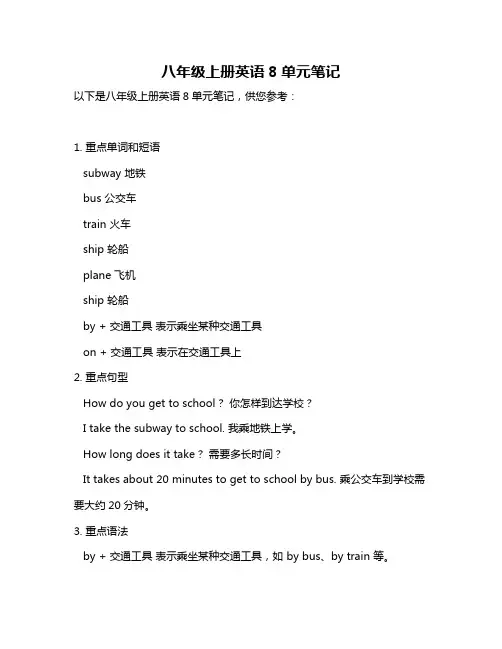
八年级上册英语8单元笔记
以下是八年级上册英语8单元笔记,供您参考:
1. 重点单词和短语
subway 地铁
bus 公交车
train 火车
ship 轮船
plane 飞机
ship 轮船
by + 交通工具表示乘坐某种交通工具
on + 交通工具表示在交通工具上
2. 重点句型
How do you get to school?你怎样到达学校?
I take the subway to school. 我乘地铁上学。
How long does it take?需要多长时间?
It takes about 20 minutes to get to school by bus. 乘公交车到学校需要大约20分钟。
3. 重点语法
by + 交通工具表示乘坐某种交通工具,如 by bus、by train 等。
on + 交通工具表示在交通工具上,如 on the bus、on the train 等。
4. 练习题
选择题:How do you get to school? I _______ the bus. ( )
A. take
B. by
C. on
D. at
答案:A。
句意:你怎么到达学校?我乘公交车。
A选项是动词;B选项介词by表示乘坐某种交通工具;C选项介词on表示在……上面;D选项介词at表示在某个时间点。
根据句意,故选A。
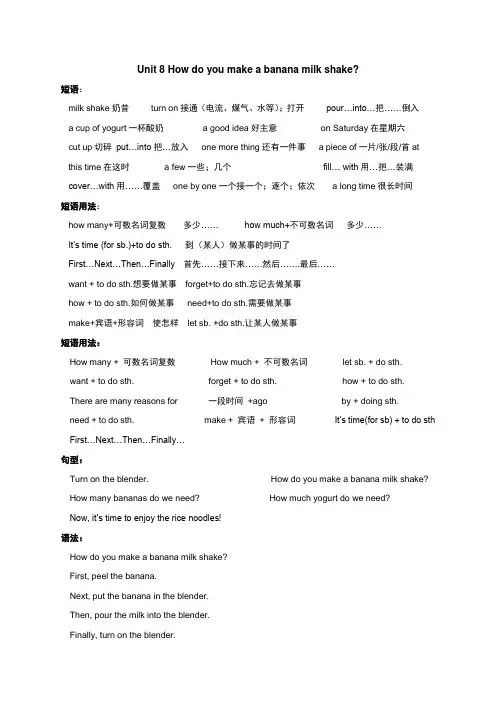
Unit 8 How do you make a banana milk shake?短语:milk shake奶昔turn on接通(电流、煤气、水等);打开pour…into…把……倒入a cup of yogurt一杯酸奶 a good idea好主意on Saturday在星期六cut up切碎put…into把…放入one more thing还有一件事 a piece of一片/张/段/首at this time在这时 a few一些;几个fill… with用…把…装满cover…with用……覆盖one by one一个接一个;逐个;依次 a long time很长时间短语用法:how many+可数名词复数多少…… how much+不可数名词多少……It’s time (for sb.)+to do sth. 到(某人)做某事的时间了First…Next…Then…Finally 首先……接下来……然后…….最后……want + to do sth.想要做某事forget+to do sth.忘记去做某事how + to do sth.如何做某事need+to do sth.需要做某事make+宾语+形容词使怎样let sb. +do sth.让某人做某事短语用法:How many + 可数名词复数How much + 不可数名词let sb. + do sth.want + to do sth. forget + to do sth. how + to do sth. There are many reasons for 一段时间+ago by + doing sth.need + to do sth. make + 宾语+ 形容词It’s time(for sb) + to do sth First…Next…Then…Finally…句型:Turn on the blender. How do you make a banana milk shake? How many bananas do we need? How much yogurt do we need?Now, it’s time to enjoy the rice noodles!语法:How do you make a banana milk shake?First, peel the banana.Next, put the banana in the blender.Then, pour the milk into the blender.Finally, turn on the blender.Countable nouns Uncountable nounsHow many bananas do we need? How much yogurt do we need?We need three bananas. We need one cup of yogurt.主谓一致判断法:1. 不可数名词作主语时,谓语动词用单数。
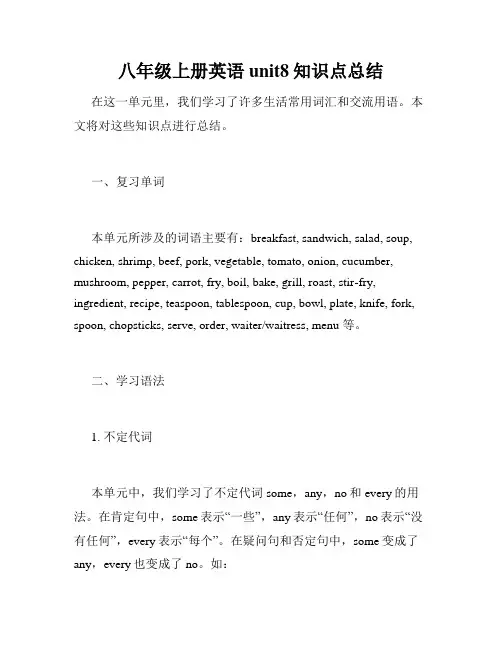
八年级上册英语unit8知识点总结在这一单元里,我们学习了许多生活常用词汇和交流用语。
本文将对这些知识点进行总结。
一、复习单词本单元所涉及的词语主要有:breakfast, sandwich, salad, soup, chicken, shrimp, beef, pork, vegetable, tomato, onion, cucumber, mushroom, pepper, carrot, fry, boil, bake, grill, roast, stir-fry, ingredient, recipe, teaspoon, tablespoon, cup, bowl, plate, knife, fork, spoon, chopsticks, serve, order, waiter/waitress, menu 等。
二、学习语法1. 不定代词本单元中,我们学习了不定代词some,any,no和every的用法。
在肯定句中,some表示“一些”,any表示“任何”,no表示“没有任何”,every表示“每个”。
在疑问句和否定句中,some变成了any,every也变成了no。
如:Would you like some soup? 你想来点汤吗?There isn’t any beef in the refrigerator. 冰箱里没有牛肉。
2. 可数名词和不可数名词在本单元中,我们还学习了可数名词和不可数名词的用法。
可数名词有单数形式和复数形式,而不可数名词只有单数形式。
如:I have two eggs for breakfast. 我今天早餐吃了两个鸡蛋。
I’d like some tea. 我想要些茶。
3. 情态动词情态动词在英语中用来表达说话人的意愿、能力、推测等情态。
在本单元中,我们学习了can和should的用法。
can表示能力,“能”,should表示建议,“应该”。
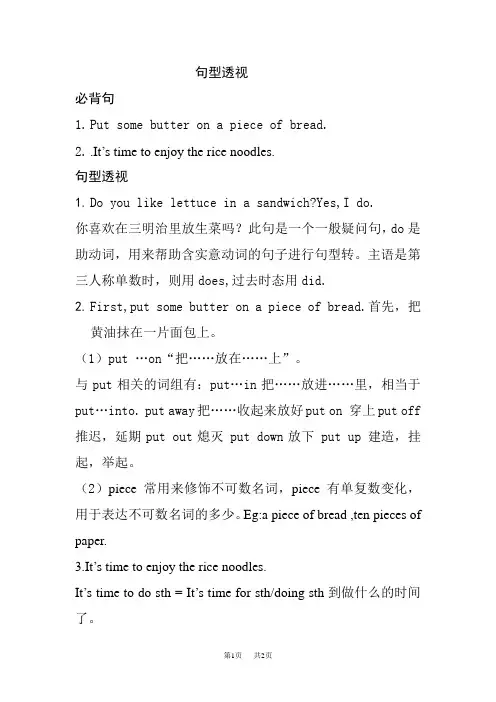
句型透视
必背句
1.Put some butter on a piece of bread.
2..It’s time to enjoy the rice noodles.
句型透视
1.Do you like lettuce in a sandwich?Yes,I do.
你喜欢在三明治里放生菜吗?此句是一个一般疑问句,do是助动词,用来帮助含实意动词的句子进行句型转。
主语是第三人称单数时,则用does,过去时态用did.
2.First,put some butter on a piece of bread.首先,把
黄油抹在一片面包上。
(1)put …on“把……放在……上”。
与put相关的词组有:put…in把……放进……里,相当于put…into. put away把……收起来放好put on 穿上put off 推迟,延期put out熄灭 put down放下 put up 建造,挂起,举起。
(2)piece 常用来修饰不可数名词,piece 有单复数变化,用于表达不可数名词的多少。
Eg:a piece of bread ,ten pieces of paper.
3.It’s time to enjoy the rice noodles.
It’s time to do sth = It’s time for sth/doing sth到做什么的时间了。
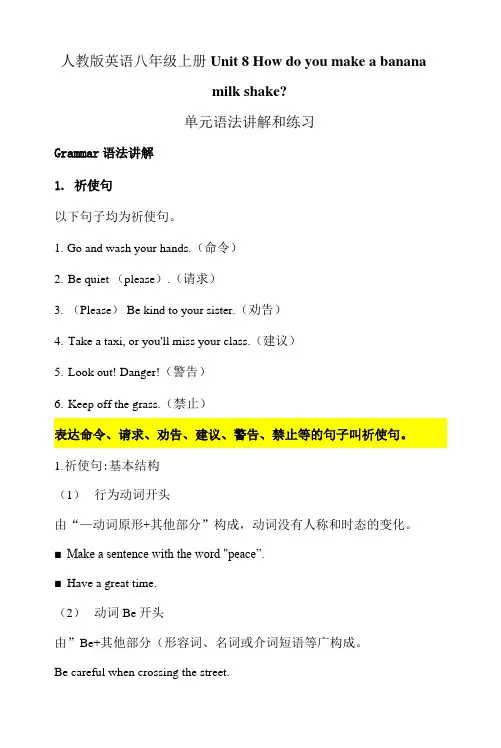
人教版英语八年级上册Unit 8 How do you make a bananamilk shake?单元语法讲解和练习Grammar语法讲解1.祈使句以下句子均为祈使句。
1.Go and wash your hands.(命令)2.Be quiet (please).(请求)3.(Please) Be kind to your sister.(劝告)4.Take a taxi, or you'll miss your class.(建议)5.Look out! Danger!(警告)6.Keep off the grass.(禁止)1.祈使句:基本结构(1)行为动词开头由“—动词原形+其他部分”构成,动词没有人称和时态的变化。
■Make a sentence with the word "peace”.■Have a great time.(2)动词Be开头由”Be+其他部分(形容词、名词或介词短语等广构成。
Be careful when crossing the street.(3)Let开头由“Let+宾语+动词原形+其他部分”(动作执行不包含听话者) 或"Let's+动词原形+其他部分”(动作执行包含听话者在内)构成。
■Let him go back now.Let us try again.(不含听话者)让我们再试一下吧。
■Let's try again.咱们再试一下吧。
祈使句:否定形式(1)行为动词和be开头的祈使句的否定形式为在句首加Never或Don't■Never/Don!t say that again!■Never/Don^ be careless. o(2)Let开头的祈使句■Don't let me go with her tomorrow.=■Let me not go with her tomorrow.可在Let前加Dont,也可在Let后宾格的名词或代词后面加note如果以Let's开头的祈使句,必须在Let's后加not。
人教版八年级上册英语Unit 8 知识点语法归纳总结一、过去进行时(Past Continuous Tense)过去进行时用于表示过去某一时刻或某段时间正在进行的动作或状态。
1. 构成肯定句:主语 + was/were + 动词的ing形式否定句:主语 + was/were not + 动词的ing形式一般疑问句:Was/Were + 主语 + 动词的ing形式?肯定回答:Yes, 主语 + was/were.否定回答:No, 主语 + wasn't/weren't.2. 使用场景过去进行时常用于以下场景:- 表示过去某一时刻正在进行的动作- She was cooking dinner when I arrived. (我到达的时候,她正在做晚饭。
)- 表示过去某一段时间内持续进行的动作- They were playing basketball all afternoon. (他们整个下午都在打篮球。
)- 表示过去两个同时进行的动作- While he was studying, I was watching TV. (他在研究的时候,我正在看电视。
)二、过去完成时(Past Perfect Tense)过去完成时用于表示在过去某一时间或动作之前已经发生的动作或状态。
1. 构成肯定句:主语 + had + 过去分词否定句:主语 + hadn't + 过去分词一般疑问句:Had + 主语 + 过去分词?肯定回答:Yes, 主语 + had.否定回答:No, 主语 + hadn't.2. 使用场景过去完成时常用于以下场景:- 表示在过去某一时间或动作之前已经发生的动作- They had already left when I arrived. (当我到达时,他们已经离开了。
)- 表示过去某一时间之前已经完成的动作- She had finished her homework before dinner. (她在晚饭之前已经完成了作业。
过去进行时态讲解和巩固练习一、含义:①过去某个时间正在发生的动作例:He was cooking at six last night. 昨天晚上六点,他正在做饭。
②过去某段时间正在发生的动作例:I was staying here from March to May last year. 去年从3月到5月,我一直呆在这里。
二、标志词at nine last night/ at that time= then/at this time yesterday /或有when the teacher came in/ while he was reading的提示三、构成过去进行时的构成:was\were +现在分词四、运用 1、过去进行时的四个基本句型肯定句 He was cooking at six last night. 否定句 He was not cooking at six last night. 一般疑问句 Was he cooking at six last night? 回答 Yes ,he was. No, he wasn’t.特殊疑问句 What was he doing at six last night?2、过去进行时的固定句型Jim was reading when the teacher came in. 当老师进来的时候,吉姆正在读书。
Jim was reading while Kate was watching TV. 在凯特正在看电视的同时,吉姆正在读书。
Jim came in while Kate was watching TV. 在凯特正在看电视的时候,吉姆进来了。
3、请比较He watched TV last night. (过去时间last night, 用一般过去时)He was watching TV at nine last night. (过去时间last night+点时间at nine, 用过去进行时)4、中考连接①—“ What ' s the matter, Ali? You look sad. ”—“ Oh, nothing much. As a matter of fact(实际上), I _____________ (think of)my friends back home. ”②.I don ' t think Jim saw me; he ______________(do)his homework carefully.③. --- I called you at 4:00 yesterday afternoon, but no one answered.--- Sorry, I _____ with my friends at that time. [2011河南]A. swimmedB. swamC. will swimD. was swimming④. --- Amy, I called you yesterday evening, but nobody answered the phone.--- Oh, I ____ a walk with my mother at that time. [2011宁波]A. takeB. tookC. am takingD. was taking巩固练习一、用所给动词的适当形式填空1. Now Jim’s sister __________________(read) newspapers.2. He __________________(watch)TV at nine last night.3. He __________________(watch)TV last night.4. What __________________the twins ________________(do) then?5. ________Lily ______________(draw) a cat when the teacher came in ?------No, she _________6. __________________you __________________(have) supper at that time?7. Jack __________________(not read) a book at nine yesterday evening.8. Now Jim __________________(play) basketball on the playground(操场).9. What ___________________ he ___________________ (do) at nine o’clock last night.10.They ___________________ (listen) to the music at that time.11. When the teacher came in, the students ___________________ (read) the text.12. We ___________________ (watch) TV when suddenly the telephone rang.13. Her mother ____________(cook) while her father was watching TV.二、改错:每处划线中有错误,在题后改正1. Linda was write carefully at nine last night.2. Tomorrow they were swimming in a river.3. At that time, she listening to the radio.4. Jim and I was playing when he came in.5. I was studiing English when he knocked at the door.6. Were you cooking a meal? ------Yes, I were.7. I weren’t doing my homework while Jim was listening to the radio.8. The students were put the apples in the box then.三、按要求句型转换:Mary was riding a bike at that time.•否定句:__________________________________•一般疑问句:______________________________•两回答:__________________________________•特殊疑问句:______________________________。
八年级上册英语unit 8知识点英语是一门广泛使用的语言,掌握好英语是非常有必要的。
而英语的学习需要我们逐渐积累一些基础知识,比如八年级上册英语unit 8知识点。
那么,在本篇文章中,我们将会对这个知识点进行详细介绍。
一、时间状语从句时间状语从句主要指在句子中用来表示时间的从句。
它们的形式通常是由连词when, while, after, before等引导的,使用这些从句可以使英语的表达更加清晰。
例如:1. I usually read books when I have free time.2. After I finish my homework, I will go out to play soccer.3. Before you leave, please turn off the lights.二、虚拟语气虚拟语气指表示假设、虚构情况或者与现实相反的语气。
在学习英语时,虚拟语气是一个比较难懂的知识点。
它通常用于宾语从句、表语从句、条件状语从句中,形式可以是过去式、should/would/could+动词原形等。
例如:1. If I were you, I would go to see the doctor.2. It is necessary that he should be here on time.3. I wish I could speak English fluently.三、被动语态被动语态是英语中一个非常重要的语法知识点。
在英语中,被动语态通常用于强调或不知道行为的执行者,而主动语态则强调行动的执行者,形式通常是“be+过去分词”。
例如:1. The book was written by him.2. The window was broken by the little boy.四、情态动词情态动词是表示说话人的心理状态、想法或说话人与读者之间的关系的词汇,如can, may, should, must, will等。
八年级上册u8笔记
以下是八年级上册Unit 8的笔记,供您参考:
1. 重点单词:掌握课本中的重点单词,包括它们的拼写、发音和用法。
2. 语法点:掌握一般现在时、现在进行时和一般过去时的用法,特别是动词的第三人称单数形式和动词的-ing形式。
3. 常用表达法:掌握一些常用的表达法,如询问对方正在做什么,询问对方是否在做某事等。
4. 课文理解:理解课文中的对话和短文,掌握其中的重点词汇和表达法。
5. 练习巩固:通过练习巩固所学知识,提高自己的语言运用能力。
6. 听力训练:通过听力训练提高自己的听力水平,掌握一些常用的听力技巧。
7. 口语训练:通过口语训练提高自己的口语表达能力,掌握一些常用的口语表达方式。
以上是Unit 8的主要学习内容,建议您在学习过程中认真听讲,及时总结
笔记,多做练习,提高自己的语言运用能力。
最新人教版八年级上册英语 unit8详细知识点Grammar: 可数名词与不可数名词;祈使句Topic: 描述制作过程;遵循指令做事1. a piece of … 一片/张/段/条/根/幅/首……2. one by one 一个接一个;逐个;依次3. a cup of yogurt 一杯酸奶4. traditional food 传统的食物5. the main dish 主菜6. at a very high temperature 用高温7. ta ke one’s temperature 量某人的体温8. add some salt to the soup 往汤里加点盐add … to ... 把……加到……上/里面9. pour …into… 把……倒入/灌入… 10. make a list of … 列一份… 清单11. put the corn into the popcorn machine 把玉米放入爆米花机里put…into…把…放入…12. rice noodles 米粉13. another 10 minutes = 10 more minutes 又/再十分钟14. Let me think(…): 让我想一想Let me see= Let’s see. 让我想想看15. peel three bananas. 剥三根香蕉16. dig/dug a hole 挖坑17. First…Next…Then…Finally 首先……接下来……然后…….最后……18. That’s it. 表示某事了结、停止、结束19.one more thing = another one thing还有一件事20.in a different way 用一种不同的方式21. mix together 混合到一起.22. take out a book from the library = take a book out of the library 从图书馆里借出一本书23. How do you make a banana milk shake? 你怎样制作一份香蕉奶昔?(n)摇动;抖动:Give the bottle a good shake. 好好地摇一下瓶子.(v) (使)摇动/颤抖:Shake the bottle before drinking.抖落: He shook the snow off his coat at the door.shake hands 握手shake one’s head 摇头for a shake 一瞬间24. Turn on the blender. 打开搅拌器.turn on:打开(电、煤气、水等)Will you please turn on the light? It’s too dark.turn off: 关掉(电、煤气、水等)Please turn the light off when you leave the building.turn up: 调高(音量等)I can’t hear clearly,please turn up the radio.出现If he doesn’t turn up in ten minutes,we’ll have to go.turn down: 调低(音量等):Please turn down the TV when I’m talking onthe phone.拒绝She turned down his invitation.25. cut up the bananas. 把香蕉切碎.cut:(n)切口;伤口;(v) 切,割,剪,砍,削等cut… into… :把…切成… cut the turkey into pieces.cut off:切断;中断He almost cut off his finger while working.cut up 切碎;剁碎cut the onion up in small pieces.伤害;折磨:He was cut up badly when he fell off his bike.cut down:砍倒;削减They cut down the old trees in order to build a new factory.22.A: How much yogurt do we need? B: We need one cup of yogurt.1). how many: 多少+ 可数名词:how many watermelons do you need?how much 多少+ 不可数名词:How much cheese/sugar do we need?多少钱= What’d the price of…? How much is the butter? 2). (n) : There’s no need for you to hurry. 你没有必要慌张.Sb. need sth. She needs help.实) Sb. need to do sth. You need to get it back tomorrow.需要;Sth. need doing = sth. need to be done. The bike needs repairing.必须(v情: ) 用于否定和疑问: You needn’t tell me. 你没有必要告诉我.Need I go there? Yes,you must./have to. No,you needn’t.in need of…: 需要… at need: 在紧急时23.Next,fill the turkey with this bread mix. 接下来,把这个面包混合物填充到火鸡里.使充满;装满: fill A with B = A be filled with B = A be full of B1). Fill the bottle with water. = The bottle is filled with / is full of water.占据,胜任(职位;工作) : She is the best person to fill this kind of job.(n)混合物(=mixture);食品混合干配料 a cake mix使掺和;使混合:She mixes the flour and milk together.2). mix…with…: 把…与…调在一起 He mixed red paint with yellow paint.(v ) mix… into…: 把…掺在…里面 She mixed some salt into the soup.调制: mix salad 拌色拉24. When it is ready , place the turkey on a large plate and cover it with gravy.(n) 盖子;封面;罩: The book has a blue cover.覆盖;遮盖: cover … with… = …be covered with…(v) She covered the table with a cloth. = The table was coveredwith a cloth.掩饰;隐瞒 Jim tried to cover his mistake with a joke.25. Finally , serve it to your friends with some vegetables. 最后,与其它食物一起端出来供朋友使用.为…服务/工作/效力: serve people. 接待;服侍(顾客):Are you being served? 你点过菜了吗?/有人接待你吗?端出(食物);伺候…进餐:serve the fish to the guests.26. Now , it’s time to enjoy the rice noodles! 现在,到了享用米粉的时候了.for sth. : It’s time for supper. to do sth. It ’s time to have supperfor sb. to do sth. It’s time for you to get up.可数名词与不可数名词1. 可数名词 ----可数名词指物体的数量可数.其单数形式可在名词前加a 或an ,表示“一个”,如:a banana.其复数形式要在词尾加s 或es (特殊情况除外),如:two bananas.名词复数的不规则变化:man-men woman-women policeman (男警察)-policemen policewoman (女警察)-policewomen mouse-mice child-children foot-feet tooth-teeth fish-fish sheep-sheep deer -deer people-people Chinese-ChineseJapanese-Japanese1)以f(e)结尾的名词变复数leaf→leaves half→halves wife→wives knife→knives shelf→shelves wolf→wolves thief→thieves2)以o结尾的: hero,Negro,tomato,potato + es; 其他的都加s:radio,zoo.表示“某国人”的名词变复数中日不变英法变,其他-s加后面. Chinese,Japanese,Englishman,Frenchman,American,Australian,German2. 不可数名词 -------不可数名词指物体的数量不可数.不可数名词没有单复数之分,也不能在词前直接加冠词a或an.表示不可数名词的数量时可在不可数名词前加相应的数量词构成短语. 如:a piece of…, a glass of…, a bottle of…., a bag of…, a teaspoon of…等.二.1.既可修饰可数名词也可修饰:all,some,most,a lot of,lots of,plenty of …2.修饰可数名词的词有:数词(one...),few,a few,many,a number of,numbers of...3. 修饰不可数名词的词有:little,a little,a bit of,much,a great deal of,a large amount of4. 不可数名词通常用“数词+量词+of+不可数名词”表示复数:three pieces of paper祈使句一.定义:祈使句指的是表示命令、请求、建议或劝告的句子.其主语you常省略,谓语动词用原形,句末用感叹号或句号,读降调.二.结构:1. 肯定的祈使句:动词原形+其他Stand up,please. Be careful!2.否定的祈使句: 1). Don't + 动词原形Don’t laugh at others.2). Never do sth. Never do that again!3). No + v-ing/n. No smoking! No noise,please.4). Let’s not do sth. Let’s not waste time.5). Don’t let sb. do sth. Don’t let them make any noise.Unit 8 How do you make a banana milk shake?一、词汇积累1. milk shake 奶昔shake v. & n. 摇动,抖动shake hands with sb./ shake one’s hands 与某人握手2. turn on 打开反义词:turn off 关上turn up 调大,开大音量反义词:turn down 调低音量易错点:遇到动词加副词,要符合以下原则:动词加副词,名词两边放,代词放中间.e.g. turn on the radio = turn the radio on,但是turn it on 不能说turn on it3. cut up 切碎过去式:cut,过去分词:cutcut up = cut into pieces 切成碎片cut into halves 切成两半4. make v. 制作,做make sth. For sb. = make sb. sth. 为某人做某物与make 的一些搭配:make friends 交朋友make a mistake/ mistakes 犯错误make tea 沏茶v. 使役动词“使”make sb. do sth. 使某人做某事make sb./ sth. + adj. 使某人/ 某物……5. need v. & n. 需要v. need sth. 需要某物need to do sth. 需要做某事n. He can’t meet all your need.作情态动词“需要”,后面用动词原形,常用于否定和疑问句中:e.g. You needn’t finish your work now.---Need I go there with him?---Yes,you must./ No,you needn’t.6. another adj. & pron. 另一,再一e.g. Can I have another cake? (another 作形容词)Give me another. (another 作代词)注意:another 与one more 意思相同,表示另外几个时,another 后面接相应的数词,而one more 中的“one”也改为相应的数词.e.g. I want to buy another three pencils. = I want to buy three more pencils.7. forget v. 忘记反义词:remember 记得forget sth./ sb. 忘记某事/ 某人forget to do sth. 忘记去做某事(事情未做)forget doing sth.忘记做过某事(事情已做)常会遇到一个词“leave”,也可表“遗忘”leave sth. at/ in/ on + 某地把某物忘记在……8. like v. & n. & prep.喜欢;喜好;像v. like sth./ sb.like to do sth./ like doing sth. 喜欢做某事n. likes and dislikes 喜好反义词:dislikeprep. 像反义词:unlike9. traditional adj. 传统的traditional n. + al adj.10. a time to………的时间It’s time to do sth. 到了该做……的时候了It’s time for sth./ doing sth.11. give thanks for…为……表达谢意Thanks for doing sth. = Thanks for sth.12. remember v. 记得,记起,回想起remember sth./ sb. 记得某事/ 某人remember to do sth.记得去做某事(事情未做)remember doing sth.记得做过某事(事情已做)remember me to sb. 代我问候某人13. traveler = traveller 漂泊者,旅行者,游客= tourist 旅游者,观光者14. celebrate v. 庆祝,庆贺celebrate one’s birthday/ 节日/ 胜利celebration n. 庆祝15. mix … with…把A 和B混在一起be mixed with… (被动语态)16. fill… with…用……填充……be filled with = be full ofbe filled with…(被动语态)A is filled withB A被B填满(动作) A is full of B A充满着B (状态)17. cover… with…用……遮盖cover sth. with sth. be covered with 被某物覆盖(被动语态)18. serve v. 服务,提供serve sb. sth. = serve sth. to sb. 提供某人某物serve sb. 为某人工作serve service(n.) servant(佣人)19. temperature n. 温度,气温,体温(既可作可数名词,又可作不可数名词)get/ have a temperature = get/ have a fever 发烧take one’s temperature 试体温,量体温20. the reason for…是……的原因(理由)the reason to do 有理由干某事21. to make this special food 不定式做目的状语e.g. The doctor did what he could to save the injured girl. (表目的)to do 还可在句中作后置定语 e.g. I have a lot of work to do.Unit 8 How do you make a banana milk shake?本单元的话题:描述做事情的顺序和过程.(First首先,Next下面,Then然后,Finall y最后)本单元的语法:复习一般现在时.本单元的短语和知识点:1(P57,1a) turn on打开turn up调大turn off关上turn down调小Please turn on the lights.请打开灯.My father is sleeping,please turn down the radio.爸爸正在睡觉,请把收音机声音调小.2. (P58,2a) How many+可数名词复数:多少…How much+不可数名词:多少…He has eight books.他有八本书.→How many books does he have?他有多少本书?How much water does he need?他需要多少水?3. (P58,2a) 量词的用法:不可数名词常用“数字+量词+不可数名词”来表示.如:a piece of bread一片面包比较:two piece s of bread两片面包(bread为不可数名词)a glass of orange 一玻璃杯橘子汁one spoon of butter 一勺黄油4.(P58,2d)说明做某事的顺序为:First…首先,Next…下面,Then…然后,Finally…最后5.(P58,2d末行)one more thing = another one thing基数词+ more + 名词= another + 基数词+ 名词:又多少某物He ate an apple,he wanted to eat two more apples.他吃了一个苹果,还想再吃两个. 6.(P59,3c)Do you know how to plant trees?你知道如何种树吗?how to do sth.怎样做某事(疑问词后跟动词须加to,即“疑问词to do sth”)He doesn’.他不知道如何打开电脑.7.(P61,2b,4行)It’s time (for sb) to do sth是某人该做某事的时间了.It’s time for us to have lunch.是我们该吃午饭的时候了.It’s time for sth是该做某事的时间了.It’s time for the class.是该上课的时候了.8.(P61,2b,1段倒数3行)by doing sth:通过…方式He learned English by listening to the radio.它通过听收音机学习英语.9.(P61,2b,2段)fill…with…用…装满,cover…with… 用…盖住10.(P63,3a,3行)need to do sth:需要做某事He needs to buy a new pen.他需要买一枝新钢笔.。
Unit8 how was your school trip? P47
1.how was your school trip?你的学校旅行怎么样?
= how do you like…?
=what do you think of …?
2.hang out闲逛hang—hung过去式(闲逛)
hang—hanged过去式(吊死,绞死)
Eg: He hung his coat on the washing line.
P48
3.else 与other 差别
other+n 不定代词或疑问代词+else
Eg: Don’t let anyone else know this place.
Any other questions?
4.win v 赢得,获得
win后跟比赛项目,beat跟人或团体
Eg: we beat his team and won the prize.
P49
5.had a great time玩的很愉快
▲have a great time=have fun=enioy oneself
6.at the end of …在。
的最后(of 后要跟n)
in the end 最后,终于(单独用)
7.on the school trip在学校旅游中
▲on表示“进行,从事,在。
中”
▲on show 在展览on business在出差on vacation在度假8.show n. 表演,节目如a flower show a dolphin show
v. 展示show sb sth=show sth to sb展示给某人某物9.outdoor adj户外的,露天的indoor adj室内的
▲o urdoor clothes 户外衣服outdoor activities户外活动10.gift=present 礼物
▲gift 通常指昂贵的礼物
P50
11.Off adj工作,休息
▲on one's next day off在某人下次休息日
on one's last day off在某人上次休息日
have +时间+off 有多长时间假期
Eg: we will have three days off.
12.Sound(听起来)与sound like(听起来像)
▲sound 是感官动词,后跟形容词,sound like后跟名词P51
13.Have fun doing sth在。
中获得乐趣
= have fun with sth 快乐高兴地做某事
Eg: Do you have fun camping?
=Do you have fun with camping?
14.All day=the whole day全天
15.no one=nobody没有人(仅仅指人)
none一个也没有(可指人也可指物)
Eg:---Who is in the classroom?
---Nobody/No one
---How many people in the park?
---None.
16.Lucky adj 幸运的(修饰名词,用在名词之前)
luckily adv幸运地(可单独用,后跟逗号隔开)
Eg: It's raining,luckily,I bring my umbrel today.
17.Put sth out把。
拿出来,把。
放在外面
Eg: We usually put our books out in class.
18.Sale n 出售,销售
▲on sale 在出售 have a yard sale进行庭院销售。